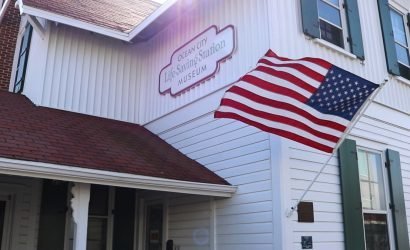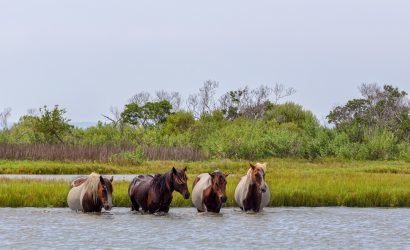If you’ve ever been to Assateague Island, chances are you’ve been lucky enough to experience the complete majesty and beauty of watching a herd of wild horses graze in the wetlands at sunset, or the sheer delight on children’s faces when they see a few 800-pound animals pass just behind their sandcastles. It’s one of the few places where that sense of living in a shared ecosystem, or being one with nature is a tangible force.
The wild horses that roam the state and national parks on Assateague Island, on both the Maryland and Virginia sides are famous in origin, akin to the tales of pirates plundering and shipwrecks full of treasures. Legend has it that a Spanish galleon wrecked just off the coast of Virginia, sending the cargo full of horses swimming to shore. The National Park Service has a differing opinion, and is that the horses were brought to Assateague by settlers in the 17th Century to avoid new fence laws. The horses are currently separated by a fence at the Maryland/Virginia boarder and managed in Maryland by the National Park Service. The Virginia herd is owned and managed by the Chincoteague Fire Department, and allowed to graze and roam on the Chincoteague National Wildlife Refuge. For this reason, and likely thanks to the famous book, Misty of Chincoteague, they are known as the Chincoteague ponies.
It’s important to understand what managing these herds entails, especially when considering one horse in particular. N10T “Ninka” is a 17-year-old mare who has gotten quite a lot of attention over the years, mostly by concerned campers or beach goers who have witnessed her rather unusual hooves. Dave Smith, veteran member of the Pony Patrol, the organization that helps to educate people on the wild horses, encouraging them to stay a safe distance away, says that people have gotten upset regarding Ninka over the years.
“Lots of people have asked about that mare. She’s been around for quite awhile. People get all up in arms about her, but the park’s policy is to not interfere with the herd,” said Smith.
 |
Although this is not an actual image of Ninka’s hooves, this animal’s condition is similar to what is observed as the overgrowth on Ninka. This is an extreme case. Photo source. |
The reason for the numerous inquiries is that Ninka has what is often referred to as “elfin shoes” or “Alladin’s slippers,” so named because the hooves curl up in the front portion. The appearance is quite unusual to see firsthand. Ninka thusly walks a little differently than other horses in her herd, but is nonetheless a fully functioning member of that herd.
These “elf shoes” are often caused by laminitis, also known as founder, a condition wherein the sensitive laminae within the hoof becomes inflamed. According to Bill Hulsander, Chief of Resources Management for Assateague Island National Seashore, laminitis in a wild horse can be caused by a number of reasons.
“One cause is a retained placenta. In horses, retention of the placenta for only a few extra hours is enough to trigger laminitis. In addition, the N10 maternal line of horses, of which Ninka is a product, has produced a number of varying grades of clubfoot and other hoof abnormalities with differing amounts of overgrowth, which periodically breaks back. Ninka’s two brothers each had an extreme hoof abnormality of a front foot, yet both lived their maximum life spans in good health as very successful harem stallions.”
Laminitis is not curable, but is often treated in domestic horses with drug therapy, diet, and a number of other ways, depending upon the initial cause. Treatment for a horse like Ninka could be difficult considering that the cause is most likely genetic. Additionally, the policy of the National Park Service is to not interfere with the horse herd, or any of the other wild animals that call Assateague home.
“Just as with deer, raccoons and other Assateague wildlife, the horses do not receive vet or farrier care, or supplemental feeding. They are not domestic animals. Our responsibility to the horses, just as with all other wildlife species on the island, is to ensure that there will always be a thriving population,” explained Hulsander.
 The Assateague horses are allowed to roam freely from the Ocean City Inlet to the Virginia boarder. They choose their own social groups to travel with, and have adapted to the harsh environment well with the hundreds of years the horses have called the barrier island home. They are also subject to any defects or disease that would affect any other wild animal.
The Assateague horses are allowed to roam freely from the Ocean City Inlet to the Virginia boarder. They choose their own social groups to travel with, and have adapted to the harsh environment well with the hundreds of years the horses have called the barrier island home. They are also subject to any defects or disease that would affect any other wild animal.
At present, it appears that despite the unusual appearance of her hooves, Ninka is functioning well within the herd. She even gave birth to a foal last year. The horses are closely monitored and park staff has observed that Ninka is maintaining her weight year-round, providing the best indication that she is otherwise in good health.
“Horses lose weight quickly when they are stressed by chronic discomfort or pain beyond what they can adapt to. Although we don’t treat naturally occurring disease or injury in the horse population, we are not insensitive to issues of pain and suffering, and provide humane euthanasia if necessary,” said Hulsander.
Despite what concerned observers of Ninka may initially assume, Ninka’s health for all accounts and purposes is considered good by park staff. She has also not lost her ability to forage for food, Hulsander assures. There is no intervention planned due to her stable health.
Have you ever seen Ninka, the horse with “elf shoes?” If so, tell us what you’ve seen.









